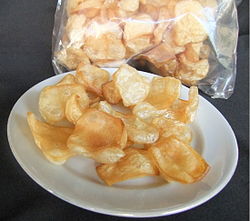Krupuk kulit
 Krupuk kulit | |
| Alternative names | Karupuak jangek (Minang), Rambak (Javanese) |
|---|---|
| Course | Snack and main course |
| Place of origin | Indonesia[1] |
| Region or state | Nationwide |
| Serving temperature | Room temperature |
| Main ingredients | Cattle skin (cow or water buffalo), diced, sun dried, and fried in coconut oil |
Krupuk kulit(Javanese:rambakorMinangkabau:karupuak jangek,lit: "skin crackers" ) is a traditionalIndonesiancattle skinkrupuk(cracker).[2]It is traditionally made from the soft inner skin of cattle (coworwater buffalo) which is diced and sun-dried until it hardens and loses most of its water content. The diced and dried skin are later fried in ample hot cooking oil until they expand similarly with bubbles and yield a crispy texture. This fried cattle skin is then sealed in vacuum plastic bags to ensure and prolong its crispiness.
History
[edit]Krupuk rambakor krupuk made from cow or buffalo skin, is the oldest-mentioned krupuk variant in ancient Java. According to a culinary historian, krupuk has been around in Java since the 9th or 10th century, written on the Batu Pura inscription askrupuk rambak,which still exists today inJavanese cuisine,usually inkrechek,a spicy stew.[1]
Serving
[edit]
Krupuk kulit is often served as a crispy snack to accompany main meals. InPadang restaurants,they are often offered as a side dish fornasi padangorsate padang,and often served withkuahgulaiseasoning. InJava,krupuk kulit is the essential ingredient forkrechek,a krupuk kulit dish in spicy coconut milk stew.
Variations
[edit]Most of krupuk kulit sold in Indonesia are made from cattle skin, either cow or water buffalo (kerbau). However, in some areas with large non-Muslimpopulations such asBali,Bataklands, and some Chinatowns inMedanand other cities,porkskin krupuk kulit is also available.[3]Compared to common cow skin crackers,kerupuk kulit babi(pork rinds) have a lighter colour and crumble more easily.[4]There is also a variant that usesfrogskin askrupuk kulit kodok.[5]

See also
[edit]- Chicharrón
- Pork rinds
- Prawn cracker,a food of similar texture and appearance made of prawn and starch
- Krupuk
Notes
[edit]- ^abWirayudha, Randy (31 August 2017)."Kriuk Sejarah Kerupuk".Historia - Majalah Sejarah Populer Pertama di Indonesia(in Indonesian).Retrieved2020-10-11.
- ^Abdul Lathief (May 14, 2012)."Kerupuk Rambak Potret Ekonomi Rakyat"(in Indonesian). Kompas.com.RetrievedMay 17,2014.
- ^Mariska Tracy (17 April 2016)."Aroy Mak Mak: Kerupuk Kulit Babi Homemade"(in Indonesian).
- ^"Membedakan Kerupuk Kulit Sapi, Kerbau, dan Babi".Sajian Sedap(in Indonesian). Archived fromthe originalon 2017-02-23.Retrieved2017-02-22.
- ^"Setahun 500 Ton Kodok Hijau Diekspor, Rp 72 Ribu per Kilo".JPNN.com(in Indonesian). 12 January 2015.
External links
[edit]
